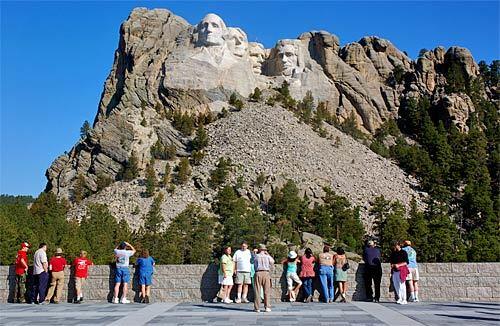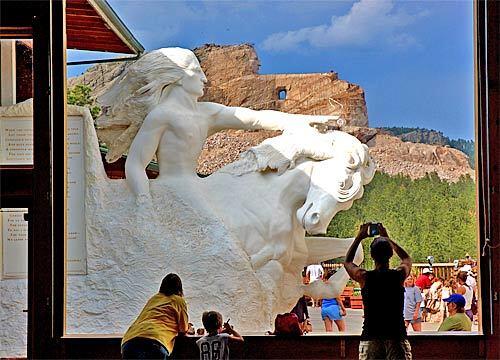Photos: Crazy Horse Memorial & Mt. Rushmore

An afternoon blast shaves 300 tons off the Crazy Horse Memorial near Mt. Rushmore in the Black Hills of South Dakota. When completed, the sculpture will show the Sioux warrior on horseback, pointing southeast to the lands where many of his people lie buried. “I just can’t conceive the engineering that’s going into this,” one visitor said, gazing up from the base of the mountain. (Chris Reynolds / LAT)
In the Black Hills, two men carved their dreams into the granite.

Grand View Terrace is a nice spot for family photo ops or just to take in the view. From the terrace, visitors can follow a half-mile loop trail that takes them to the base of the mountain and the studio of Mt. Rushmore’s sculptor, Gutzon Borglum. Those presidential visages are a symbolic representation of power, which has made the monument “a very political place” since its beginnings, says the memorial’s interpretation chief, Judy Olson. (Chris Reynolds / LAT)

Hey, Mom, how does this thing work? Two young visitors try to figure out how to get a closer look at the presidential faces carved into the granite at Mt. Rushmore National Memorial in South Dakota. Forgot your history? That’s Washington, Jefferson, Teddy Roosevelt and Lincoln serving as sentinels in the Black Hills. Rushmore is an easy drive from Rapid City, Custer or Keystone. Show up early enough and you’ll get a shaded parking place. (Chris Reynolds / LAT)

The State Game Lodge is the oldest of several lodgings in Custer State Park, just south of Mt. Rushmore. The lodge was once the summer White House for President Coolidge. Today, mere mortals can spend the night at the inn, which is situated in a mountain valley with a trout-filled creek nearby. (Chris Reynolds / LAT)
Advertisement

Visitors who are avid fans of kitsch of the Old West variety might enjoy Keystone, S.D. A mile from Rushmore, the old mining town is a riot of blinking signs and faux Old West flourishes. It’s also an overnight spot for visitors -- the town has more rooms for lodgings than full-time residents. There’s also a gallery devoted to Rushmore’s creator. (Chris Reynolds / LAT)

Mike Pflaum, a ranger with the National Park Service, enjoys the view from a rocky peak on the grounds of Mt. Rushmore. The familiar faces are startling to see in such gigantic proportions, especially when that sculpture tops a 450-foot mountain. The monument took 14 years to build and cost just less than $1 million. One short-time worker there went on to start work on his own dream -- a monument to Sioux warrior Crazy Horse. (Chris Reynolds / LAT)

Crazy Horse’s visage was completed in 1998. Ziolkowski (pronounced jewel-CUFF-ski) took up the project at the behest of Lakota (Sioux) Chief Henry Standing Bear, who was looking for somebody to carve a likeness of the Sioux warrior who prevailed over Lt. Col. George Custer at the Battle of the Little Bighorn in 1876 and was killed a year later. (Chris Reynolds / LAT)

Visitors to the memorial can compare Ziolkowski’s 1/34th scale model with the real thing. When Crazy Horse will be done, nobody knows. With just one foreman and four driller-blasters on the payroll, it could easily be a decade or more. It depends on money, geology and luck. “How much more inspiring can you get than a family-run tradition?” an Ohio tourist noted to a Los Angeles Times reporter. The visitor had seen Rushmore too but said, “This is more amazing.” (Chris Reynolds / LAT)
Advertisement

The sculpture becomes the backdrop for a summertime laser light show, captured in a long exposure. The Ziolkowski family’s cause has grown into a $6-million-a-year tourist complex that employs 135 workers in peak summer months, using revenues and donations to bankroll work on the mountain. (Chris Reynolds / LAT)



